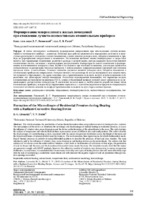Формирование микроклимата жилых помещений при отоплении лучисто-конвективным отопительным прибором

Date
2025Publisher
Another Title
Formation of the Microclimate of Residential Premises during Heating with a Radiant-Convective Heating Device
Bibliographic entry
Ливанский, Д. Г. Формирование микроклимата жилых помещений при отоплении лучисто-конвективным отопительным прибором = Formation of the Microclimate of Residential Premises during Heating with a Radiant-Convective Heating Device / Д. Г. Ливанский, Е. В. Голуб // Наука и техника. – 2025. – № 1. – С. 63-71.
Abstract
В статье исследуются особенности формирования микроклимата при использовании лучисто-конвективного отопительного прибора – радиатора. Основная цель работы заключается в определении достоинств и недостатков радиаторного отопления в жилых помещениях, оценке влияния размеров окна, габаритов помещения и прибора на формирование микроклимата в помещении. Исследование включает анализ температурных и скоростных полей в трех характерных помещениях различного размера и конфигурации. Авторы выявляют недостатки текущих отопительных систем, связанные с неравномерным распределением температуры по высоте помещения и формированием зон пониженного комфорта у окон. В работе исследуются три типичных помещения, для которых проводится математическое моделирование тепловых процессов с использованием дифференциальных уравнений для описания процессов тепло- и массообмена. Основное внимание уделяется влиянию размеров окон, габаритов помещения и отопительных приборов на микроклимат. Авторы отмечают, что радиаторы не всегда перекрывают всю ширину окон, что приводит к образованию у их краев холодных зон, к проникновению холодного воздуха вглубь помещения и образованию зон дискомфорта внутри помещения. Результаты моделирования показывают, что параметры воздуха в помещениях соответствуют нормативам ГОСТ, однако субъективный комфорт жителей может снижаться из-за неравномерного распределения температуры. В заключение делается вывод о необходимости разработки новых типов отопительных приборов, которые будут эффективнее справляться с задачей поддержания комфортного микроклимата и исключат негативное влияние на комфорт проникновения холодного воздуха через оконные проемы.
Abstract in another language
This article examines the peculiarities of microclimate formation when using radiant-convective heating device - radiator.
The main purpose of the work is to determine the advantages and disadvantages of radiator heating in residential premises, to assess
the influence of window sizes, room dimensions and the device on the formation of the microclimate in the room. The study includes
the analysis of temperature and velocity fields in three representative rooms of different sizes and configurations. The authors identify
the disadvantages of current heating systems associated with the uneven temperature distribution across the height of the room and
the formation of zones of reduced comfort near the windows. The work examines three typical rooms for which mathematical modeling of thermal processes is carried out using differential equations to describe the processes of heat and mass transfer. The main
attention is paid to the influence of window sizes, room dimensions and heating devices on the microclimate. The authors note that
radiators do not always cover the entire width of windows, which leads to the formation of cold zones at their edges, the penetration
of cold air deeper into the room and the formation of discomfort zones inside the room. The simulation results show that the indoor
air parameters comply with GOST standards, however, the subjective comfort of residents may decrease due to uneven temperature
distribution. In conclusion, it is concluded that it is necessary to develop new types of heating devices that will more effectively cope
with the task of maintaining a comfortable microclimate and will eliminate the negative impact of cold air penetration through window openings on comfort.
View/
Collections
- № 1[9]
